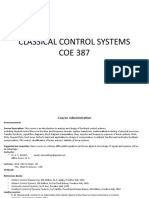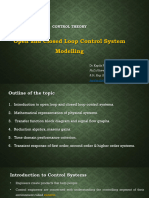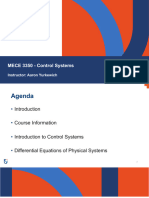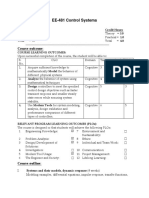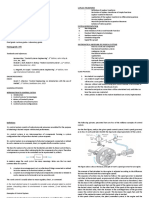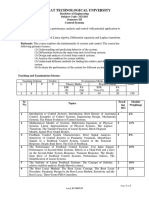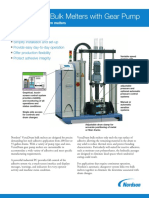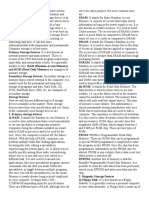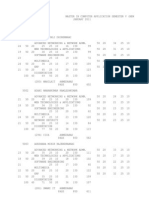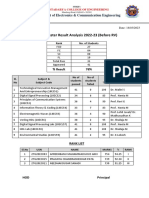ECE171A: Linear Control System Theory
Lecture 1: Introduction
Nikolay Atanasov
natanasov@ucsd.edu
1
�Outline
Course Overview
Control System Examples
Control System Modeling
2
�Outline
Course Overview
Control System Examples
Control System Modeling
3
�Overview
I ECE 171A: Linear Control System Theory focuses on modeling, analysis,
and design of single-input single-output linear time-invariant control systems
with emphasis on frequency-domain techniques
I Topics:
I Modeling: ordinary differential equations, linear time-invariant systems,
first-order and second-order systems, block diagrams and signal flow graphs
I Analysis: transient and steady-state behavior, Laplace transform, stability,
root locus, frequency response, Bode plots, Nyquist plots, Nichols plots
I Design: PID control, loop shaping
4
�Prerequisites
I Prerequisites
I Introductory physics: Newton’s law, Ohm’s law, Kirchhoff’s voltage and
current laws
I Calculus: derivatives, integration, exponential function, Taylor series
I Programming experience with MATLAB, Python, or similar language
I Optional but helpful: ordinary differential equations, linear algebra
I Courses that fulfill these prerequisites: ECE 45 or MAE 40
5
�Teaching Team
I Instructor:
I Nikolay Atanasov
I Assistant Professor, ECE department
I Email: natanasov@ucsd.edu
I Teaching Assistant:
I Shrey Kansal
I Graduate student, MAE department
I Email: skansal@ucsd.edu
6
�Discussion Session and Office Hours
I Discussion Session
I Mondays, 3:00 pm - 4:00 pm, in CENTR 222.
I Optional material and examples supplementing the lectures will be covered.
I You are encouraged to ask questions and start a discussion!
I Office Hours
I Fridays, 11:00 am - 12:00 pm on Zoom (see Canvas for information).
I No new material will be covered.
I The focus will be on answering your questions and helping you with the
material.
I Additional office hours by appointment
It would be great if most, if not all, of you attend the discussion and office hours
together. Even if you do not have questions, you can help answer other students’
questions and create a supportive community for this class!
7
�Assignments and Grading
I Course website: https://natanaso.github.io/ece171a
I Includes links to:
I Canvas: course password, lecture recordings
I Gradescope: homework submission and grades
I Piazza: discussion and class announcements (please check regularly!)
I Assignments:
I Academic integrity quiz on Canvas (due by Oct 05)
I 7 homework sets (45% of grade)
I Midterm exam (25% of grade): calculator + single-sided cheat sheet
I Final exam (30% of grade): calculator + double-sided cheat sheet
I Grading:
I A standard grade scale (e.g., 93%+ = A) will be used with a curve based on
the class performance (e.g., if the top students have grades in the 83%-86%
range, then this will correspond to letter grade A)
I No late policy: homework submitted past the deadline will not be accepted
due to our tight course schedule
8
�References
I Primary Textbook:
Karl J. Åström and Richard M. Murray, Feedback Systems: An Introduction
for Scientists and Engineers, 2008
Available at: https://fbswiki.org/
I Additional References: listed on the course website (not required)
9
�Course Schedule (Tentative)
Check the course website for reading material and schedule updates:
https://natanaso.github.io/ece171a
10
�Outline
Course Overview
Control System Examples
Control System Modeling
11
�What is a dynamical system?
I A dynamical system is a system whose behavior changes over time, often in
response to internal or external stimulation
(a) Pendulum (b) Car suspension (c) Water flow
(d) Atmospheric convection (e) Fluid dynamics (f) Sync of fish
(Lorenz system)
12
�What is a control system?
I A control system is an interconnection of components (dynamical systems)
that provides a desired response
I A controller is a component of a control system that modifies the overall
system behavior
(a) Inverted pendulum (b) Cruise control (c) Wind farm
13
�Control System
I Modern control systems include physical and cyber components
I A physical component is a mechanical, electrical, fluid, or thermal device
acting as a sensor, actuator, or embedded system component:
I A sensor is a device that provides measurements of a signal of interest
(output)
I An actuator is a device that alters the configuration of the system or its
environment (input)
I A cyber component is a software node that executes a specific function
I Control system engineering focuses on:
I modeling cyber-physical systems,
I analyzing system behavior,
I designing control techniques to achieve desired behavior
I Performance characteristics: stability, transient and steady-state tracking,
rejection of external disturbances, robustness to modeling uncertainties, etc.
14
�Open-loop vs Closed-loop Control Systems
I An open-loop (feedforward) control system utilizes a controller without
measurement feedback of the system output
I A closed-loop (feedback) control system utilizes a controller with
measurement feedback of the system output
15
�Noise and Modeling Errors
I A closed-loop control system uses the measurement feedback to compute and
reduce the error between the desired and measured output
I A closed-loop control systems may attenuate the effects of process noise
(disturbance), measurement noise, and modeling errors
16
�Feedback Control Examples
Flyball Governor (1788)
I regulate speed of a steam engine
I reduces the effect of load variations
I major advance of industrial revolution
17
�Feedback Control Examples
(a) Drones (b) Autonomous vehicles
(c) Rockets (d) Aircraft
18
�Feedback Control Examples
(e) Biological systems (f) Environmental systems
(g) Social networks (h) Finance market
19
�Feedback Control Examples
(a) Robot parkour (b) Traffic wave control (c) Autonomous flight
20
�Outline
Course Overview
Control System Examples
Control System Modeling
21
�Control System Modeling
I A mathematical model is a key element in the design and analysis of control
systems
I Dynamic behavior is described by ordinary differential equations (ODEs)
d
y (t) + a(t)y (t) = u(t)
dt
I The relationship between the variables and their derivatives in an ODE may
be linear or nonlinear
I Nonlinear ODEs are often approximated using linearization because linear
ODEs are much easier to analyze
I The coefficients of an ODE may be time-invariant or time-varying
I This class will focus on linear time-invariant (LTI) ODE systems
22
�Differential Equations of Physical Systems
I Physical systems from different domains (electrical, mechanical, fluid,
thermal) contain elements that share similar roles
Variable Electrical Mechanical Fluid Thermal
Through Current Force, Torque Flow rate Flow rate
Across Voltage Velocity Pressure Temperature
Inductive Inductance Inverse Stiffness Inertia –
Capacitive Capacitance Mass, Moment of Inertia Capacitance Capacitance
Resistive Resistance Friction Resistance Resistance
I The dynamic behavior of these elements is described by physical laws, such as
Kirchhoff’s laws or Newton’s laws, enabling an ODE description of the system
23
�Through and Across Element Variables
24
�Inductive Elements
25
�Capacitive Elements
26
�Resistive Elements
27
�Spring-Mass-Damper Example
I The behavior of a spring-mass-damper system is
described by Newton’s second law:
d 2 y (t) dy (t)
M + b + ky (t) = r (t)
dt 2 dt }
| {z | {z } |{z}
spring force input force
viscous damper
I The mass displacement y (t) satisfies a second-order
linear time-invariant (LTI) ordinary differential
equation (ODE)
28
�Parallel RLC Circuit Example
I The behavior of an electrical RLC circuit is
described by Kirchhoff’s current law:
r (t) = iR (t) + iL (t) + iC (t)
I Parallel devices have the same voltage v (t):
I Resistor: v (t) = RiR (t)
I Inductor: v (t) = L diL (t)
dt
I Capacitor: iC (t) = C dv (t)
dt
I The inductor current iL (t) satisfies a second-order LTI ODE:
d 2 iL (t) L diL (t)
CL + + iL (t) = r (t)
dt 2 R dt
29
�Laplace Transform
I The behavior of an LTI ODE system may be studied in the time domain
(t ∈ R) or in the complex (frequency) domain (s = σ + jω ∈ C)
I The Laplace transform converts an LTI ODE in the time domain into a
linear algebraic equation in the complex domain
I Example:
I Time domain LTI ODE: I Laplace domain linear algebraic eq.:
d
y (t) + 8y (t) = u(t) sY (s) − y (0) + 8Y (s) = U(s)
dt
30
�Block Diagram
I The system components may be visualized as a block diagram
I A block represents the input-output relationship of a system component
I To represent multi-component systems, the blocks are interconnected
I Signals may be added or subtracted using summing points
I A block diagram may represent a system in the time domain or in the
complex domain
I Time domain: I Laplace domain:
31
�Example: Rotating Disk Speed Control
I Line-cell imaging in biomedical applications use spinning disk conformal
microscopes
I Objective: design a controller for a rotating disk system to ensure the speed
of rotation is within a specified percentage of a desired speed
I System components:
I DC motor: provides speed proportional to the applied voltage
I Battery source: provides voltage proportional to the desired speed
I DC amplifier: amplifies the battery voltage to meet the motor voltage
requirements
I Tachometer: provides output voltage proportional to the speed of its shaft
32
�Open-Loop Rotating Disk System
33
�Closed-Loop Rotating Disk System
34
�Control System Analysis
I The system components are described using LTI ODEs
I Time domain: I Laplace domain:
I Desired speed: r (t) I Desired speed: R(s)
I Amplifier: z(t) = Kr (t) I Amplifier: Z (s) = KR(s)
I DC motor: U(s) = 200
I DC motor: u̇(t) + u(t) = 200z(t) s+1
Z (s)
I Rotating disk: ẏ (t) + 8y (t) = u(t) I Rotating disk: Y (s) = 1
s+8
U(s)
I Tachometer: ḃ(t) + 4b(t) = 4y (t) I Tachometer: B(s) = 4
Y (s)
s+4
I We will study how to choose the amplifier gain K to ensure that system
output y (t) tracks a desired reference signal r (t)
35
�Nominal Rotating Disk System
I A nominal model aims to capture the system behavior accurately but
parameter errors or disturbances might be present
I Closed-loop control becomes important when there are parameter errors and
disturbances
36
�Low-gain Rotating Disk System
I The DC motor gain might be different in the real system (e.g., 160)
compared to the nominal model (e.g., 200)
37
�Slow Rotating Disk System
I The disk might rotate slower in the real system (e.g., ẏ (t) + 2y (t) = u(t))
compared to the nominal model (e.g., ẏ (t) + 8y (t) = u(t))
38
�Open-loop Step Response
I Without feedback, the real system response might be different than what was
planned
39
�Closed-loop Step Response
I Feedback improves the sensitivity to parameter errors and disturbances
I Despite the advantages, feedback architectures need to be designed carefully
to avoid oscillations and steady-state error
40






